 |
"Oregon Trail Covered Wagon
and Cargo"
|
|
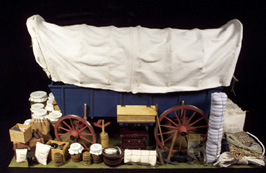 |
| |
A "hands-on" traveling
exhibit |
| |
|
2004 -- Benton County Oregon Historical Society and
History Museum
Size:
10 in. x 18 in. base
Scale: 1 in. = 1 ft. (1/12th scale)
Figures: two 5-to-6
inch tall 'cut-out' photo figures mounted on hardboard to show relative
scale.
|
|
| |
| Features:
: A robustly constructed covered
wagon with a removable top, firmly attached to a 10" x 18" base,
plus a collection of all of the provisions and belongings typically carried
by immigrants to the Oregon Territory during the 1840's. |
| This
exhibit was created as a "hands-on" educational tool to be loaned
to elementary school classes in the central Willamette Valley of Western
Oregon. The wagon is about one foot long. The intent is to provide students
with an opportunity to try to fit the scale items pictured at right and
listed below into the scale covered wagon. They also get a sense of weight
realities because the wagons had a maximum safe weight limit of one ton
- 2,000 pounds - of cargo. The chosen scenario sets the role playing parameters
as about 1845, and the wagon is being provisioned for four people: a father,
a mother, a son and a daughter between nine and twelve years old. It will
be pulled by four work horses, not oxen, as many travelers used.
In the interests of space, the draw bar was not included in the display. |
|
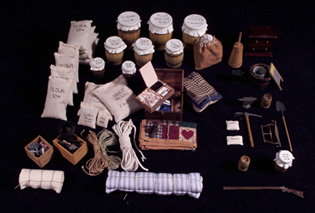
|
|
Cargo list for the Oregon Trail Wagon
|
|
1 barrel of sugar, 100#
1 barrel of pilot bread, 60#
1 barrel of dried apples, (3 bushels)
1 barrel of rice, 40#
1 barrel of salt, 40#
1 barrel of vinegar, 10 gal.
1 barrel of lard, 25#
1 barrel of cornmeal, 30#
1 barrel of lead shot, 25#
1 keg of nails, 10#
1 keg of gunpowder, 5#
8 sacks of flour, 50# ea .(200#/pers.)
|
|
2 sacks of dried beans, 2 bushels each
1 sack of bacon, 150#
1 sack of coffee beans, 25#
1 sack of tea, 8#
2 sacks of seeds
1 box of eating utensils
1 washtub, 1 bucket & 1 basin
1 cast iron kettle
1 butter churn
1 tent
1 mattress
4 blankets
|
|
1 quilt
1 small 2 drawer chest
1 pair leather boots
1 trunk of clothing
3 coils of rope, 100 ft each
1 washboard
1 candle mold
1 bow saw
1 pickaxe
1 shovel
1 anvil
1 rifle |
|
|
The full design is based upon the challenge that combining
"removable details" and "hands-on" in the same exhibit
presents for loss or damage to the exhibit. We tailored several design
elements in response to that challenge:
•The wagon box is firmly attached to the 10"x
18" landscaped base on a plexiglas pedestal which allows the wheels
to touch the "ground", but carry no stress from
the students' loading activities.
•For strength, the material chosen for the wagon box is twice as
thick as a true 1/12 scale piece of half-inch oak planking would be.
•As part of the teaching material for the borrowing
teacher to use, the design includes large-print inventory cards with the
detailed photo of the cargo on the back. Together with the sectioned cargo
storage tray (see next listing below and display case design sketch at
lower right), the process of identifying and storing the individual items
at the end of "the lesson" will promote control of the inventory,
minimize loss and serve as a dynamic review of the story.
•A sectioned/labeled tray for the transport and control of the scale
cargo pieces, which stores/travels under the wagon base, is also included.
•There is a clear carrying case, with the wagon/base firmly affixed
to a pedestal bottom, and storage space for the cargo tray and teaching
materials --- this is designed for a "gather around" presentation,
not a "pass it around" one.
|
|
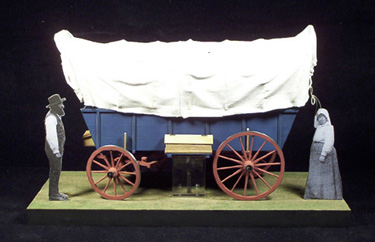
The images used for the cut-out figures were scanned from
a historical photo from the client's archive. |
|
| |
|
| |
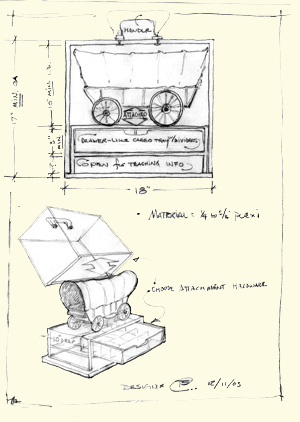 Design sketch of clear travel / display / storage case.
Design sketch of clear travel / display / storage case. |
|
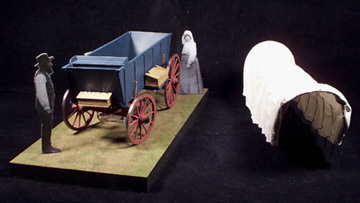
•The "cover" is stiff and its "hoops"
are attached to the inside so, with the cover lifted off, the loading is
easy to do and see.
|
|
|
|
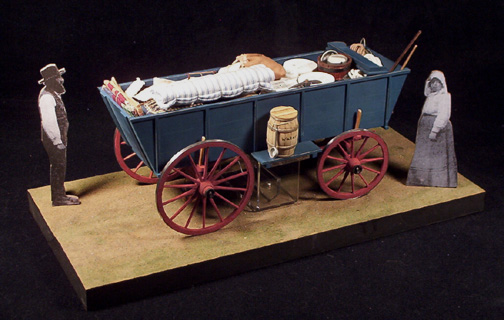
|
|
Even when care is used in loading the items,
the bare essentials fill the wagon to the brim (left). To help the elementary
school students to appreciate the realities of load weight, the flour bags
are filled with sand, and other bags and sacks are filled with H.O. scale
model railroad "ballast" (fine gravel). The wagon itself is modeled
after an authentic Oregon Trail wagon from the Cal Young collection of artifacts
and is now on display at the Lane County Oregon History Museum in Eugene,
Oregon. The colors are also inspired by the Cal Young wagon. The wagon's
draw bar and attendant cross trees were not included in the display because
they would double the overall length of the exhibit, and they don't contribute
to the story. The "cover" and it's bows cannot be attached to
the wagon box when loaded, encouraging the desired "re-inventory and
return to the travel tray". |
|
|
|
Website designed by Moments In Time Exhibits
Contact webmaster
with comments/questions.
|
|
|
|
|
|
|
|
|
|
|
|
|
|
|
|
|

